Instructional programs for native Hawaiian, American Indian, First Nations, Alaska Native, and other indigenous populations have come a long way in the last fifty years. When I started teaching over forty years ago, most Indian students were housed and taught in boarding schools or other settings isolated from mainstream public schools. These boarding schools were operated by the federal government under the Bureau of Indian Affairs under different mandates and guidelines than public schools. Personnel were hired and fired under civil service regulations rather than state or national education standards.
For example, in 1967, I taught at a large boarding school called Intermountain Indian School. My class of 21 students ages 12 to 17 was identified as "special education" but the students were placed in the program based on juvenile detention records rather than exceptionalities, disabilities, or other special needs as defined today. There were no provisions for following the Individuals with Disabilities Education Act nor for providing desegregated instruction in the least restrictive environment. The students at this school were all a long way from home and rarely if ever had the opportunity to go home for holidays or breaks. I witnessed students being physically punished for using their native language and for 'speaking back' to their teacher and was asked to leave my position when I raised objections to this treatment.
"Civilizing" the Students
During this period, it was government policy in the larger boarding schools to discourage the use of the home language at school and there were signs in the dormitories reading "Tradition is the Enemy of Progress". As Bureau of Indian Affairs teachers, we were taught that our primary responsibility was to "civilize" the students. This was done in larger boarding schools through regimented barrack-like discipline, teaching proper English table manners during meals, and lessons in proper hygiene and behavior to one another. In 1969, I taught at a large boarding school in Chinle, in northwestern Arizona, where students were marched to and from the cafeteria and would be put in detention if they got out of line or spoke to one another.
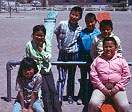 In 1970, I had a classroom of 35 non-English speaking Diné (Navajo) students, ages 5 to 12 years old, at the Nazlini Boarding School up in the hills some miles south of Chinle. The picture to the right is of 6 of my Beginners students. Things at Nazlini were not as tightly structured as at Chinle Boarding School and a more family like atmosphere was cultivated, though the principles of strict discipline and civilization were still enforced regularly by our administrator. This boarding school consisted of a dormitory, classroom building, and cafeteria where 125 Diné students were housed, fed, and cared for.
In 1970, I had a classroom of 35 non-English speaking Diné (Navajo) students, ages 5 to 12 years old, at the Nazlini Boarding School up in the hills some miles south of Chinle. The picture to the right is of 6 of my Beginners students. Things at Nazlini were not as tightly structured as at Chinle Boarding School and a more family like atmosphere was cultivated, though the principles of strict discipline and civilization were still enforced regularly by our administrator. This boarding school consisted of a dormitory, classroom building, and cafeteria where 125 Diné students were housed, fed, and cared for.
My class was called a Beginners class and included all students who were coming to school for the first time and did not speak English. The text was an old Fries American English Series teachers' guide. The Fries materials were published during and after World War II for teaching English as a foreign language in occupied territories and other overseas settings. The students at the boarding school spoke Diné at home and a mix of English and Diné at school. Their parents would drive them to the school compound in wagons and buckboards drawn by horses, in the back of a pickup truck or would walk with them to the school to enroll them. At this time most families lived in hoghans (8 sided log houses) many miles from the school facilities, hauled water from windmill driven wells, and spent much of their time herding sheep and goats. At this school, it was not unusual for a family member to 'check out' a student so they could stay home over the weekend.
Teaching English as a Second Language
During the 60's and 70's while I taught for the Bureau of Indian Affairs, English as a second language was taught separately from content instruction. Little or no accommodations for the linguistic or cultural differences of Indian students were made in content instruction and the pedagological model for ESL was based upon English as a foreign language models. This changed only gradually as materials were developed based upon a more functional understanding of the acquisition of English as a second language within American schools. Indian students during this time had the lowest national high school completion and college completion rates of any students in American schools.
Students stayed in the Beginners classroom until they had enough English to transfer into a grade level classroom with a monolingual English speaking teacher who taught math, science, social studies, and language arts. There were classroom aides who spoke the native language in some classrooms but they mostly helped with paperwork and discipline issues. An exception to this was the Rough Rock Demonstration School, where a standardized written form of the Diné language was used to produce primary language instructional materials. This excellent program had limited influence in surrounding schools because few people were literate in Diné at the time.
Because I wanted my students to get into grade level as soon as possible and to do well academically, I integrated content instruction into my ESL curriculum and acquired enough Diné to provide primary language scaffolding for them (I tossed the Fries in a box and designed my own materials). When I had an aide in my room, they were given instructional duties and assisted with content instruction in the primary language. This was not generally the case in other classrooms as teachers were admonished not to "fraternize with the natives" and associated only with staff within the school compound. As I spent a lot of time in the community organizing an elders' school advisory council and visiting homes, I did not spend much time inside the compound.
The Beginning of Bilingual Special Education
Among my 30 to 36 Beginners students each year were children who did not appear to learn as their peers. Although I spoke some Diné and had a successful English transition program, there were about 5 students each year that struggled with lessons and keeping up with their peers. In the early 70's there was no such thing as mainstreaming or resource rooms for students with learning and behavior problems in Indian schools.
Children born with disabilities needing medical attention were taken away from their families and sent to facilities far from the reservation. Children with other special needs, born at home away from doctor's eyes generally stayed home and were kept out of sight when government workers came by. Children with more mild learning and behavior problems in school did the best they could as long as they could and then dropped out. Bureau of Indian Affairs teachers did not receive training in working with students with special needs because these students were not going to be in their classrooms. I took a furlough, went back to school to get a teaching certificate in learning disabilities, training as a diagnostician, and established a screening program and resource room at the Nazlini Boarding School, the first bilingual special education classroom in the area.
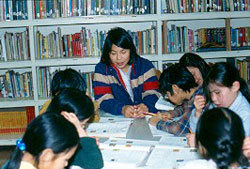 During this era I worked with a team of folks to establish a bilingual residential program for Diné children and youth with multiple and severe special needs. We literally had folks bringing us their youngsters whom they had hidden from government workers for years. We had folks bring us their young people out of facilities in Phoenix where they had been taken away and institutionalized. I had a mother bring me her 8 year old child strapped into a cradle board because he could not walk or feed himself. This program became the Chinle Valley School and still exists.
During this era I worked with a team of folks to establish a bilingual residential program for Diné children and youth with multiple and severe special needs. We literally had folks bringing us their youngsters whom they had hidden from government workers for years. We had folks bring us their young people out of facilities in Phoenix where they had been taken away and institutionalized. I had a mother bring me her 8 year old child strapped into a cradle board because he could not walk or feed himself. This program became the Chinle Valley School and still exists.
While teaching at Cibecue Boarding School, my assistant Judy DeHose (now president of the tribal school board) and I started a bilingual special education program for Apache students. We were able to use funds from Title I and later Title VII of the Elementary and Secondary Education Act to set up and maintain these programs.
Within that act, bilingual education was defined as "the use of two languages, one of which is English, as mediums of instruction of the same pupil population in a well organized program which encompasses all parts of the curriculum and includes the study of the history and culture associated with the mother tongue...a complete program develops and maintains the children's self-esteem and a legitimate pride in both cultures." Targeted funds were made available in the late 1970's and early 80's from federal programs for schools serving Hawaiian, American Indian and Native Alaskan students to provide bilingual support including restoration, transition, and maintenance language programs.
Later these programs were strengthened by the passage of the Native American Languages Act in 1990 that had the goal to "preserve, protect, and promote the rights and freedom of Native Americans to use, practice and develop Native American languages."
A Return to Language Preservation
As boarding schools were phased out and reservation based school systems were taken over by the tribes, many tribes instigated language restoration or language maintenance programs depending upon the relative strength of the native language within their communities. Examples of this are the programs developed in Colorado (Ute), Arizona (Hopi, Diné, and Apache) and New Mexico (Pueblo, Zuni), South Dakota (Lakota), Washington (Lummi, Lushootseed), Oregon (Goshute, Paiute) and in the Great Lakes region (Oneida, Chippewa, and Ojibwa) to name just a few.
 The picture to the left is of a student at the Rock Point Elementary school in the Diné Nation. Rock Point and Rough Rock had fully developed bilingual programs at this point. Tribes also formed partnerships with local public school districts to provide meaningful language support for their students attending tribal or local public schools on or near reservation land.
The picture to the left is of a student at the Rock Point Elementary school in the Diné Nation. Rock Point and Rough Rock had fully developed bilingual programs at this point. Tribes also formed partnerships with local public school districts to provide meaningful language support for their students attending tribal or local public schools on or near reservation land.
In general, however, public schools have followed the political winds in their states and have predominantly English immersion, English only, or transitional pull-out type ESL programs for Native American students, especially in urban, suburban or rural areas away from reservations or large tribal communities. This was especially true as the wave of English Only legislation was passed in states after 1993.
Indian students are immersed in the general education curriculum and, in the main, their native languages were not considered a matter for instruction or consideration in programming. Special counseling and assistance programs are sometimes available where a district has an active Native American community or the school district has tapped into federal funding such as Title III, IV, or V funds.
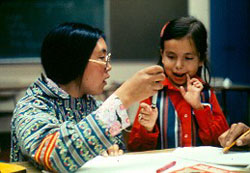 In the late 1970's I accepted a job as an itinerant diagnostician with a Child Find project in Alaska. We flew out to villages in the Yukon Kuskokwim region in southwest Alaska and tested young children from Yup'ik speaking families. I was a combination school psychologist and special education teacher and my job was to assess, identify, and proscribe interventions and services for children identified as eligible for special services. Some children could be served in the village school under an individual education plan after I trained the local teachers what to do, some children needed to come into facilities in Anchorage at certain times of the year. With some children, I went into the homes and worked with parents or grandparents about the interventions their young one needed. The picture to the right is from a training program we started in Alaska for preparing Head Start workers in language development and early language intervention assistance.
In the late 1970's I accepted a job as an itinerant diagnostician with a Child Find project in Alaska. We flew out to villages in the Yukon Kuskokwim region in southwest Alaska and tested young children from Yup'ik speaking families. I was a combination school psychologist and special education teacher and my job was to assess, identify, and proscribe interventions and services for children identified as eligible for special services. Some children could be served in the village school under an individual education plan after I trained the local teachers what to do, some children needed to come into facilities in Anchorage at certain times of the year. With some children, I went into the homes and worked with parents or grandparents about the interventions their young one needed. The picture to the right is from a training program we started in Alaska for preparing Head Start workers in language development and early language intervention assistance.
Even in public school programs with large limited English speaking migrant, refugee, and immigrant populations who use local translators and provide primary language support for their ELL students do not generally include indigenous language speakers even when they also are limited English proficient. Outside of reservation communities or tribal school systems there are very few integrated bilingual, dual language, two way immersion programs in an American Indian or Alaska Native language in American schools. Data from 2005 and 2006 shows that native students continue to have the lowest completion rates of any group in the U.S. and continue to be disproportionately placed in special education.
Success Stories
Some exceptions are notable, however. In Hawaii, the Kamehameha School continues a long tradition of instruction and support in native Hawaiian language and culture. In Alaska, as local public schools took over from Bureau of Indian Affairs schools, many continued to provide instructional support in the local Alaskan native language along with English as a second language instruction. In a joint project with the University of Alaska, Kuskokwim Community College, and the Lower Kuskokwim School District, we were able to continue preparing bilingual education personnel, developing and publishing bilingual materials, and implementing a primary Yup'ik program begun by Bureau of Indian Affairs schools in the Yukon Kuskokwim region.
Through this project, we provided college degree track courses for Yup'ik speaking community members in 15 villages in the Yukon Kuskokwim region of Alaska. A sister program in Chup'ik was started in the northern part of the region. When I left Alaska in the early 80's to finish my doctorate, we had over 300 Yup'ik and Chup'ik speaking villagers in the teacher preparation program.
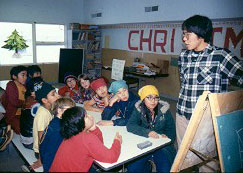 At the Alaska state Bilingual Multicultural Education and Equity conference this year, I was honored to see many of my Alaska Native graduates still teaching, working with bilingual programs, and making presentations about instructional strategies for diverse learners.
At the Alaska state Bilingual Multicultural Education and Equity conference this year, I was honored to see many of my Alaska Native graduates still teaching, working with bilingual programs, and making presentations about instructional strategies for diverse learners.
Of particular note was a presentation about a charter school in Bethel, Alaska, with a K-5 dual language Yup'ik program which has met its Annual Yearly Progress goals under No Child Left Behind for two years running. These exemplary programs for native Hawaiian, American Indian, First Nations, Alaska Native, and other indigenous populations show what is possible to achieve in modern school systems and provide guidance to our efforts to continue to improve the graduation rate of our native students.
In my years in the field I have seen an overthrow of the worse examples of inappropriate education for indigenous, first nations, and native students and the gradual development of programs that illustrate best practice. It is my hope that these models can be implemented in all schools serving our diverse students.
About the Author
This article was written for Colorín Colorado by Dr. Catherine Collier, a leader in the fields of cross-cultural, bilingual, and special education. Dr. Collier currently is the director of CrossCultural Developmental Education Services (CCDES), a company offering support and professional development opportunities to community organizations, departments of education, school districts, teachers, and parents.
To learn more about Dr. Collier, read her From the Heart interview with Colorín Colorado!

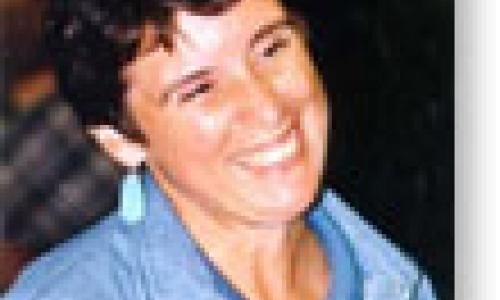







Add new comment